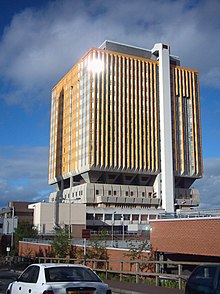Belfast City Hospital
| Belfast City Hospital | |
|---|---|
| Belfast Trust | |
 |
|
| Geography | |
| Location | 51 Lisburn Road, Belfast, County Antrim, Northern Ireland, United Kingdom |
| Organisation | |
| Care system | Health and Social Care in Northern Ireland |
| Hospital type | District General |
| Affiliated university |
Queen's University of Belfast Ulster University |
| Services | |
| Emergency department | No, A&E Closed 2011 |
| Beds | 900 |
| History | |
| Founded | 1841 |
| Links | |
| Website | Home page |
| Lists | Hospitals in Northern Ireland |
The Belfast City Hospital (Irish: Ospidéal Chathair Bhéal Feirste) located in Belfast, Northern Ireland, is a 900-bed modern university teaching hospital providing local acute services and key regional specialities. Its distinctive tower block dominates the Belfast skyline being the third tallest storeyed building in Ireland (after Windsor House and Obel Tower, both in Belfast). It has a focus on the development of regional cancer and renal services. It is the largest general hospital in the United Kingdom.
The City Hospital began life as a workhouse on the Lisburn Road in the early part of the 19th century.
The Belfast Board of Guardians was started on 11 May 1841 and from the beginning provided sick beds for the poor who did not have access to healthcare services provided by the government.
Because it became difficult to separate the sick from the destitute, the Workhouse was developed into a Workhouse Infirmary, which soon had over 600 beds. The largest number of patients in the Belfast Union Infirmary was recorded as 4,252 on 31 January 1869.
Dr. Thomas Andrews, who qualified as a doctor in Edinburgh in 1835, was appointed by the Guardians at the age of 26 to work with the growing patient population and paid him £60 per annum. Belfast grew to a city of 350,000 people in Victorian times but the city had a problem with poor housing and sewage which led to at least four Cholera outbreaks. In 1847 the first Fever Hospital was opened by the Board of Guardians which was enlarged to 600 beds.
In 1849 all fever patients were removed from the wards of the Frederick Street Hospital and transferred to the Infirmary or Fever Hospital on the grounds of the current City Hospital. This decision meant reduced bed numbers in the main Belfast General Hospital but that the amount of surgery now done there increased. In addition to the "fever" patients, the Infirmary also agreed to take all patients with burns, and those with incurable illnesses to the point where they were as many as 1,338 patients in 1883.
The Fever Hospital treated outbreaks of cholera, smallpox, tuberculosis, measles, diphtheria, typhoid, scarlet fever and rabies. The number of nurses grew over these years although they were often untrained. In 1867, there were fifteen paid nurses. In November 1884, Miss Ella Pirrie was appointed Superintendent and Head Nurse. She knew Florence Nightingale and in December 1884, Miss Nightingale sent a Christmas present to Miss Pirrie for the children in the Infirmary. Shortly after she was appointed, the Guardians approved a uniform for the paid nurses, and a distinctive apron for the unpaid female attendants. Under Miss Pirrie, nursing training began for the first time in Belfast and the first person, Miss Craig was sent to Dublin to sit a nursing examination. Nurse Craig was appointed Superintendent in 1892.
...
Wikipedia
